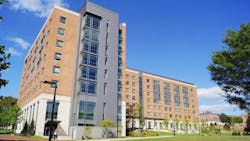University of Maryland residence hall receives LEED Gold
Prince Frederick Hall, a residential facility at the University of Maryland, College Park, has received LEED Gold certification from the U.S. Green Building Council.
The building, which opened in 2014, has lower operating costs, higher water efficiency, optimized energy performance, and lower greenhouse gas emissions compared with comparable facilities.
Prince Frederick houses 462 students in a combination of singles, doubles and four-person semi-suites.
Among the sustainable or green features incorporated into the design and operation of building:
- More than 75 percent of all construction debris was diverted from landfills and processed by recyclers for use in other construction projects.
- Water-efficient plumbing fixtures save more than 30 percent over conventional fixtures.
- The heating and cooling systems are designed to perform 22 percent better than a prototypical baseline standard used to evaluate building performance.
- The building has energy-efficient windows, occupancy sensor lighting controls, and elevators that can generate some electricity for the building on each trip.
- At least 10 percent of the building materials and fixtures were extracted, harvested, recovered or manufactured within 500 miles of the project site.
- Certain construction materials and finishes were made from low-emitting materials that off-gas fewer harmful compounds.
- Housekeeping and pest control programs use low-emitting products that are friendly to the environment.
- Single-stream recycling is heavily promoted, and convenient recycling containers are dispersed throughout the building.
Prince Frederick is the seventh campus building to achieve LEED Gold, the university says. Maryland law requires that all state-funded buildings be built to meet at least LEED Silver standards. The university is working to reduce its greenhouse gas emissions 50 percent by 2020, and achieve carbon neutrality by 2050.
About the Author
Mike Kennedy
Senior Editor
Mike Kennedy, senior editor, has written for AS&U on a wide range of educational issues since 1999.
